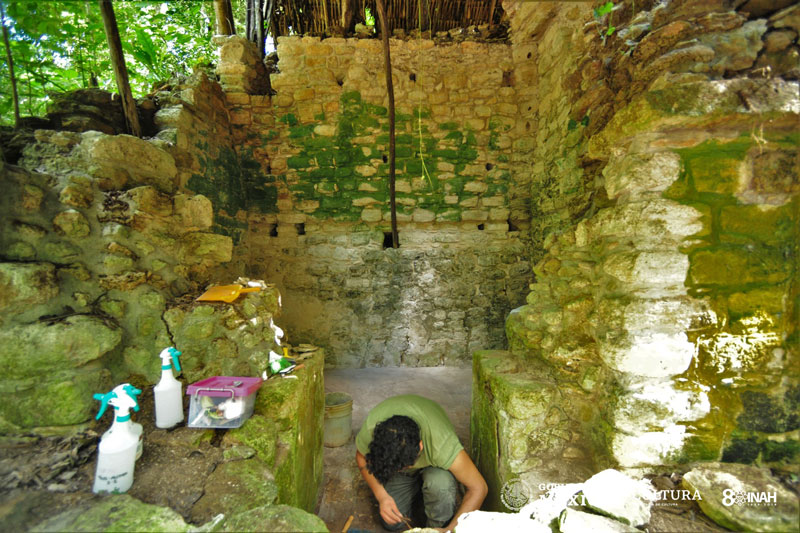Anthropology
Related: About this forumKulub: Dig uncovers large Mayan palace in Mexico
7 hours ago

REUTERS
There are fears the site is too exposed to sun and wind
Archaeologists in Mexico have uncovered the ruins of a large palace they believe dates back to the height of the Mayan civilisation, 1,000 years ago.
Remains of a building six metres (20ft) high, 55m long and 15m wide were found at a dig on the site of the ancient city of Kulubá in Yucatán state.
It is thought the structure was used over two periods of Mayan history as far back as 600 AD.
The Mayan civilisation flourished before Spain conquered the region.
More:
https://www.bbc.com/news/world-latin-america-50920236
Clash City Rocker
(3,546 posts)We were in Cancun in November. I thought they were about due to uncover some new Mayan ruins.
Judi Lynn
(164,039 posts)Friday, December 27, 2019

Mexico Kuluba Palace
KULUBA, MEXICO—The Guardian reports that a team of archaeologists from Mexico’s National Institute of Anthropology and History have unearthed the remains of a six-room palace at the site of Kuluba in northeast Yucatan. The structure stretches some 180 feet long and stands up to 20 feet high. According to archaeologist Alfredo Barrera Rubio, one of the project's leaders, the building is part of a larger complex that includes an altar and residential rooms, and appears to have been in use from A.D. 600 to 1050. “We know very little about the architectural characteristics of this region," said Rubio. "So one of our main objectives, as well as the protection and restoration of cultural heritage, is the study of the architecture of Kuluba.” To read more about ancient Maya centers, go to "The City at the Beginning of the World."
https://www.archaeology.org/news/8321-191227-maya-palace-discovered
Karadeniz
(24,716 posts)Judi Lynn
(164,039 posts)to reveal so many cities which have been covered by jungle or sand for so many centuries, and in some cases, thousands of years,
all over the world.
So much might be discovered in a comparatively short time span. Pyramids, cities, in Africa under so much sand, pyramids, cities in Central and South America!
Judi Lynn
(164,039 posts)Archaeologists think it was occupied by Maya elite more than 1,000 years ago

Parts of Kulubá are already open to the public, and the INAH hopes the newly discovered palace will become accessible “in the medium term.” (Mauricio Marat/INAH )
By Brigit Katz
SMITHSONIANMAG.COM
DECEMBER 27, 2019
At the archaeological site of Kulubá, nestled amid the lowland forests of Mexico’s Yucatán state, experts have unearthed the remains of a large palace believed to have been used by Maya elite around 1,000 years ago.
According to Emma Graham-Harrison of the Guardian, the structure spans nearly 20 feet high, 180 feet long and almost 50 feet wide. It appears to have consisted of six rooms, and is part of a larger complex that includes two residential rooms, an altar and an oven. Mexico’s National Institute of Anthropology and History (INAH) says archaeologists also uncovered a burial containing “various individuals” during excavation of the palace; the organization hopes that anthropological examination of these remains will help shed light on the people who once populated Kulubá.
Experts think the site was occupied for two distinct periods: between 600 to 900 A.D. and 850 to 1050 A.D. The first era of habitation falls within the Classic Period of the Maya civilization, when the ancient people occupied a swath of territory across Mexico, Guatemala and northern Belize. They built thriving cities, and their population swelled to more than 19 million people. By around 900 A.D., however, many major Maya cities had collapsed for reasons that remain unclear; researchers have suggested challenges associated with climate change (including extreme drought), warfare and changing trade patterns played a role in the decline.
But the Maya didn’t simply vanish after their empire fell. As cities in the southern lowlands of Guatemala, Mexico, Belize and Honduras—“the heart of Maya civilization,” according to History.com—were abandoned, locations in the northern lowlands began to thrive. Among them was Chichén Itzá, a city in Yucatán state that shows signs of having been taken over by warriors of the Toltec people in the 10th century. And as the city persisted past the Classic Period, so did Kulubá. Based in part on similarities between ceramic materials found at both sites, archaeologists believe that Kulubá was under the control of Chichén Itzá, the INAH explains.
More:
https://www.smithsonianmag.com/smart-news/ancient-maya-palace-was-discovered-yucatan-state-180973866/